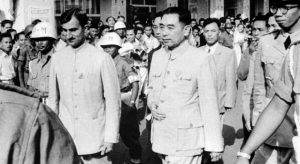Bandung conference or people known as the Asian-African conference is the biggest conference held in Bandung as the famous city in Indonesia. It happened in about seven days between 18 – 24 April 1955 in Merdeka building. The conference consist of a country that just reaches its freedom, such as Indonesia.

Asian – African conference used to be held by five countries such as Myanmar, Sri Lanka, India, Pakistan, and includes Indonesia. The coordinator of this conference was Sunario as the ministry of foreign affairs.
Asian – African conference was attended by 29 countries to discuss their concern about the cold war that may affect their countries. As for Indonesia, Soekarno as the president at that time was concern about the contradiction with Netherland towards west Irian.

That is why this conference is important for Indonesia. If you want to know more about the Asian – African conference, let’s check them below! We will completely peel about the background history, the purpose, and the result about it as part of the interesting facts about Bandung.
1. Background History
Background of Asian – African conference preceded by the trial of Bogor on 28 – 29 December 1954. This trial was held in Bogor which was preceded as the Asian – African conference and Kolombo conference.

Before Bogor’s trial, on August 23, 1953, Ali Sastroamijoyo as the prime minister from Indonesia suggest about the importance of cooperation between some countries in Asia and Africa for world peace.
Asian – African conference is a reflection of their concern about western colonialism between America and China. Besides, there was a cold war and Russian conflict that may affect some important decisions in the Asian country.

Asian – African conference also discussing Aljazair freedom from France, west Irian from Netherland, and reconciliation between China and America. This conference was build to makes Asian county stronger than before.
In December 1954, the United Nations confirmed west Irian which was already placed in the assembly for Indonesia in the next 1955. At the same time, the declaration about Asian – African conference also came out as the brief history of Bandung Indonesia.
2. The Purpose
The purpose of the Asian – African conference is to unite the cooperation to fight colonialism. In 1955, most countries still fight their freedom among Soviets, the United States, and other imperialists.

That is why some countries reach their freedom trying to help them who still under attack. The conference is so helpful such as helping Aljazair to get their freedom from France and helping Indonesia with the west Irian case fight Netherland as part of the histories of Dutch colonization in Indonesia.
Besides political needs, the cultural and economic aspects also become the other purpose of the conference. Each country will promote the Asian-African economic and cultural toward making great cooperation.
3. The Result

Asian – African conference in Merdeka building in 1955 has an important result which is referring to the charter of the United Nations. It calls as Dasasila Bandung which follows by those rules below.
- Respect for basic human rights and the goals and principles contained in the charter of the United Nations (United Nations)
- Respect for the sovereignty and territorial integrity of all nations
- Recognizing the equality of all ethnic groups and the equality of all nations, large and small
- Do not intervene or interfere in the domestic matters of other countries
- Respect the rights of every nation to defend themselves individually or collectively in accordance with the UN Charter
- Do not use the rules of collective defense to act in the special interests of one major power and do not do so against other countries
- Do not take actions or threats of aggression or use violence against the territorial integrity or political independence of a country
- Settling all international disputes by peaceful means, such as negotiations, agreements, arbitration (settlement of legal problems), or other peaceful means, according to the choice of the parties concerned in accordance with the UN Charter
- Promote common interests and cooperation
- Respect international laws and obligations
4. The Impact
The final decision of the Asian – African conference underlined the need for developing countries to loosen their economic dependence. They decided on leading industrialized countries by providing technical assistance to one another through the exchange of experts.

Besides, for some countries which leading the most will give some technical assistance for development projects, as well as the exchange of technological, how-to and institutional knowledge, regional training and research.
In 2005, as the conference reach about 50 years the committee was trying to gather a new meeting of the Asian – African conference. At that time, the conference has to result in the new Asian – African strategic partnership (NAASP). They believe that the conference will bring the best future for them.

At 2015, as the third meeting and the conference reaching 60 years, Asian – African conference was held again in Bandung. The conference was attended by 89 heads of state/government from 109 countries in the Asia and Africa, 17 observer countries, 20 international organizations, and 1,426 representatives of domestic and foreign media.

The conference resulting in a new stronger NAASP, Bandung Messages, and the declaration of Pakistan independence.
So, there is a short of description about the Asian – African conference held in Bandung, Indonesia. This conference has a big impact on whether for the developing country or the developed one.
For Indonesia, it can make great unites from the culture and rise the economical growth. That makes the connection between Indonesian cultural value and other Asian countries becomes stronger in so many aspects.
